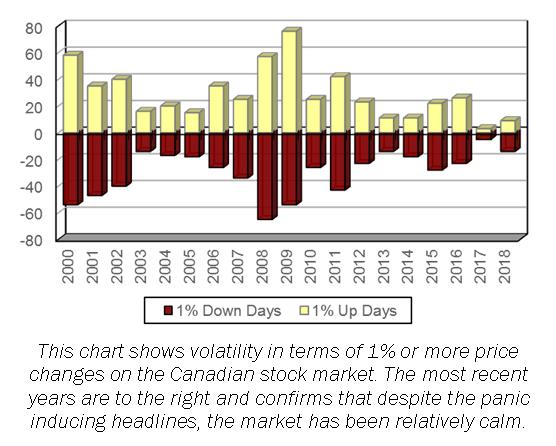Knowledge Centre
Bursting the High Volatility Bubble
December 2018
Volatility is on most investors’ minds as stock markets are gyrating like a hula hoop around the hips on a windy day. 2018 definitely feels volatile, but that may be due to how tame and placid 2017 was in comparison. Certainly inter-day peaks and valleys might push even the calmest of investors around the bend. However this clanging is just noise for the most part, as that sells newspapers (or in today’s vernacular, “drives eyeballs to websites”); the real picture comes into focus when you step back and look at the long term.


Rather than looking at volatility based upon the standard deviation of average returns over various time frames, let’s examine volatility by determining the number of day-to-day extreme changes in the Canadian stock market. In other words, how many days in each year have there been changes in the S&P/TSX Stock Index of 1% or more, either up or down. As the chart below and data to the left show, current volatility levels are not even close to being high. In fact, we are very close to being in one of the least volatile periods since 2000. Whoosh, the balloon deflates!
For the first 11 months of this year we experienced 23 days of market price movements of +/- 1% or more, the second lowest period since 2000. This compares with only 8 days in 2017 of extreme price movements, the lowest volatility since 2000. This screams of a huge surge in volatility, but to put it into context, the average annual number of extreme price movement days in Canada is 59 days so we are actually experiencing abnormally low volatility.
For a longer time frame of reference, since 1928 the S&P 500 in the U.S. has averaged 62 days of price movements of greater than +/- 1% each year. Like Canada, 2017 was extremely docile with only 8 days of extreme price movement in the U.S., but so far this year volatility has ramped up, with 55 days of market price movements of +/- 1% or more. This figure is well over double Canada’s (139% to be exact), and despite the intense media focus that all markets are getting risker, this did not apply to Canada.
What is really interesting is that 40% of the extreme price movement days in Canada have occurred since the end of September, as concerns about trade, slowing global economic growth and higher interest rates began to batter stocks. Still, many stock investors view the return of volatility as healthy, as it serves as a reminder that investing is risky and markets do not just march higher. It also can help prevent bubbles from forming and reduce price valuation pressure.
The current bout of worry and trepidation has set in as investors feel this latest period is abnormal because market pundits are fixated on the near past when markets had sleepwalked forward at a steady pace. But now that the sleepwalking markets have woken up, investors need to wake up as well and realize they need to understand what is happening.
MARKET DATA

This report may contain forward looking statements. Forward looking statements are not guarantees of future performance as actual events and results could differ materially from those expressed or implied. The information in this publication does not constitute investment advice by Provisus Wealth Management Limited and is provided for informational purposes only and therefore is not an offer to buy or sell securities. Past performance may not be indicative of future results. While every effort has been made to ensure the correctness of the numbers and data presented, Provisus Wealth Management does not warrant the accuracy of the data in this publication. This publication is for informational purposes only.
Contact Us
"*" indicates required fields
18 King St. East Suite 303
Toronto, ON
M5C 1C4
